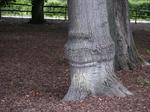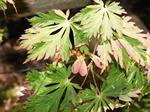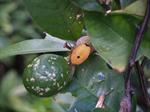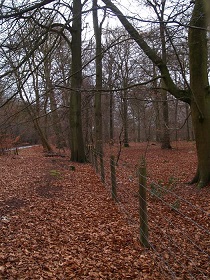
Study Tree Identification, Culture and Management
All too often trees are the forgotten giants of our garden areas. A shrub or ground cover plant is far closer to the human eye than a tree, and these plants usually get most of our attention because they are so easily seen. With trees it often seems to be "out of sight, out of mind".
Begin your journey into tree care
 Trees are potentially far greater problems than shrubs. If a shrub blows over, it creates a bit of a mess and a gap in the garden bed. If a tree blows over, it can destroy half the garden, make a large hole in the roof of a house, or crush your new car. Trees, like people, can be hurt, they can get sick, and sooner or later they will die. They need to be fed and watered, and they do need "doctoring" if their life is to be extended to the fullest. Some trees, like some people, are hardier and never seem to become ill. In the same way, however, many trees have "medical" problems which no one seems to notice until it is too late!
Trees are potentially far greater problems than shrubs. If a shrub blows over, it creates a bit of a mess and a gap in the garden bed. If a tree blows over, it can destroy half the garden, make a large hole in the roof of a house, or crush your new car. Trees, like people, can be hurt, they can get sick, and sooner or later they will die. They need to be fed and watered, and they do need "doctoring" if their life is to be extended to the fullest. Some trees, like some people, are hardier and never seem to become ill. In the same way, however, many trees have "medical" problems which no one seems to notice until it is too late!
This course covers techniques and practices used to cultivate trees so as to maintain them in good health. This includes things like selecting appropriate trees for the conditions, planting and staking, watering and how to fertilise different trees, types of pruning, cabling and bracing damaged tree limbs, diagnosing problems such as nutritional disorders, controlling pests and diseases, transplanting and tree removal.
CONTENT
There are eight lessons in this module, as follows:
 1. Introduction To Arboriculture
1. Introduction To Arboriculture
2. Tree Biology
3. Soils In Relation To Trees
4. Diagnosing Tree Problems
5. Tree Surgery
6. Pruning Of Trees
7. Arboricultural Equipment
8. Workplace Health & Safety.
AIMS
- Describe measures to provide healthy trees in different situations, including appropriate plant selection.
- Explain tree biology, including morphology, anatomy and physiology, as it relates to arboriculture.
- Develop procedures to manage soils for improved tree growth.
- Develop procedures for managing health disorders with trees, including environmental, pest and disease problems.
- Determine surgical techniques commonly used in arboriculture to repair damage to plants
- Explain tree surgery techniques commonly used in arboriculture to prune growth.
- Determine appropriate equipment for arboricultural practice.
- Determine appropriate workplace health and safety practices for an arboricultural workplace.
EXAMPLES OF WHAT YOU MAY DO
- Distinguish between plants in order to identify at many different trees.
- Develop a standard tree report form, customised for surveying the condition and use of trees in your locality.
- Explain how to treat three specified soil related problems that can effect trees.
- Develop a twelve month program, for managing a health problem detected by you in an established tree.
- Demonstrate bridge grafting across a bark wound.
- Distinguish between different methods of pruning including: -Canopy reduction -Cleaning out -Topiary -Espaliering
- Determine the minimum equipment required to commence business as a tree surgeon.
- Compare different chainsaws, to determine appropriate applications for each.
- Determine legislation which is relevant to a specific arborist in a workplace which you visit.
WHY CHOOSE THIS COURSE?
- Course notes and materials are unique (written by our staff) and up to date (most revised annually) –our graduates are more up to date with what they learn than many other institutions.
- We don’t just present you with information; we also work to help you understand and remember it, develop an ability to apply it in the real world, and build networks with others who work in this field.
- Start any time, study at your own pace, study from anywhere
- Don’t waste time and money traveling to and from classes
- More choices in your assignment work –courses are written to allow you more options to focus on parts of the subject that are of more interest to you.
- Tutors more accessible than many colleges – academics are hard at work in both the UK and Australia, 5 days a week, 16 hours a day, and answering individual queries from students are top priority and always attended to within a day –often within an hour.
- Be treated like an individual –don’t get lost in a crowd of other students. Our tutors interact with you one to one.
- Extra help at no extra cost where needed.. If you find a task you can’t do, we will help you through it or give you another option.
- Support after graduation –We will advise on getting work, starting a business, putting a CV together. We will promote students and their businesses through our extensive profile on the internet. Any graduate who asks will be helped.
WHAT ARBORISTS DO
Artboriculture work involves managing trees and everything that is involves with establishing new trees, maintaining them throughout their life, and removing them either when they die, or it becomes inappropriate to keep them.
Some trees only live for a decade or two; but m,ost live much longer; and some for hundreds of years.
It is important to consider your choice of tree for any location very carefully; because what you establish is likely to have a very long term impact in the place you plant it. That impact can be positive or negative; risky or safe, pleasing or unpleasing and costly or inexpensive.
Arborists may be involved in tree planting, transplanting, pruning and tree surgery, climbing, landscape design and planning, feeding, watering, other after-care and advice, identification and control of pest and disease, tree felling, wood chopping, chipping and stump removal.
The work can be physically challenging; but also intellectually demanding.
WHAT YOU WILL STUDY?
- Introduction to Arboriculture
- Which trees to plant?
- How to plant a tree
- Planting Bare-Rooted Trees
- Planting Advanced Trees
- Helping the Tree Settle In
- How to transplant a tree
- Plant Guards
- Tree Biology
- Tree growth
- Photosynthesis
- Respiration
- Transpiration
- Tree physiology
- How a tree grows
- Compartmentalisation - how a tree rots
- Water and plant growth
- Factors affecting the rate of photosynthesis, respiration and transpiration
- Terminology
- Soils in Relation to Trees
- Soils and tree growth
- Soils: practical tests and exercises
- Soils in relation to trees
- Naming the soil
- The nutrient elements
- Soil PH
- Fertilisers
- Diagnosing Tree Problems
- Tree health disorders
- Frost protection
- Dealing with plant problems
- Conducting an inspection
- Diagnosis of plant disorders
- Environmental problems
- Fertilisers
- Pests and diseases
- Pests
- Tree Surgery
- Tree surgery techniques
- Tree climbing techniques
- Pruning of Trees
- Removing trees
- Terminology
- Arboriculture Equipment
- The arborist’s equipment
- Power tools
- Tool maintenance
- Deciding what is a good buy
- Chain saws
- Hedge trimmers
- Safety equipment for climbers
- Workplace Health and Safety
- Duty of care
- Workplace safety
- Lifting and manual handling
- Protective equipment
- Handling tools and machinery - general safety rules
- Basic rules for safe handling a chain saw
- Tool maintenance

How You Study
- When you enroll, we send you an email that explains it all.
- You are given a short orientation video to watch, where our principal introduces you to how the course works, and how you can access all sorts of support services
- You are either given access to your course online, or sent a CD or course materials through the mail (or by courier).
- You work through lessons one by one. Each lesson has at least four parts:
- You are given access to and encouraged to use a range of supplementary services including an online student room, including online library; student bookshop, newsletters, social media etc.
- You are provided with a "student manual" which you can refer to if and when needed. It provides a quick solution to most problems that might occur (some people never need to use this; but if you are studying late at night & have a problem, the manual provides a first port of call that can often get you moving again).
How This Course Could Help You
Knowledge of trees helps many people do their job properly including:
Arborists
Gardeners
Tree technicians
Council workers/contractors
Environmentalists
Those doing environmental reports
Those assessing sites or specified trees during development work
People working in re-vegetation
People working in rehabilitation of sites e.g. farms, mining areas, reafforestation etc.
Those assessing trees for public safety